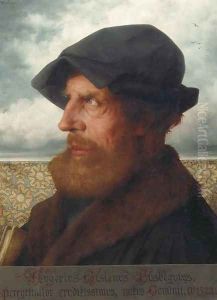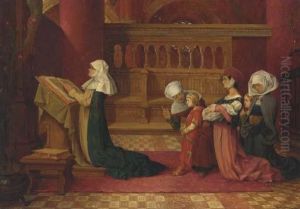Theophile Lybaert Paintings
Théophile Lybaert was a Belgian painter and sculptor born in Ghent on the 23rd of July, 1848, and died on the 16th of March, 1927. His work is often associated with the academic and classical traditions, reflecting the training and artistic norms of the late 19th century. Lybaert received his education at the Royal Academy of Fine Arts in Ghent, where he later became a professor, influencing a generation of Belgian artists.
Lybaert's oeuvre is characterized by its focus on historical, religious, and mythological themes, often executed with a meticulous attention to detail and a profound sense of realism. His paintings are known for their dramatic intensity and emotional depth, qualities that made him a respected figure among his contemporaries. In addition to his paintings, Lybaert also produced a number of sculptures, showcasing his versatility and skill in different artistic mediums.
Throughout his career, Lybaert was awarded several honors and his work was exhibited widely, both in Belgium and abroad, earning him international recognition. His contributions to the art world were not only limited to his own creations but also included his role as an educator, shaping the artistic techniques and perspectives of future artists.
Despite his success during his lifetime, Théophile Lybaert's work is less well-known today outside of Belgium. However, his paintings and sculptures continue to be appreciated by art historians and collectors for their technical excellence and emotional resonance. His legacy lives on through his contributions to the Royal Academy of Fine Arts in Ghent and the pieces of his work that are preserved in various museums and private collections.
Lybaert’s approach to art, deeply rooted in the academic tradition, reflects the broader artistic movements of his time, including Romanticism and early Realism. His ability to capture the essence of his subjects, whether in the delicate features of a mythological figure or the solemnity of a religious scene, speaks to his mastery of form and composition. In an era that was on the cusp of modernism, Théophile Lybaert remained a steadfast proponent of traditional artistic values, leaving a body of work that continues to inspire admiration for its beauty and craftsmanship.











